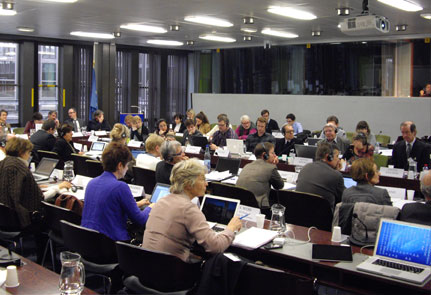Adoption of EUCERD Recommendations on European Rare Disease Reference Networks promotes access to diagnostics and care
 At the seventh meeting of the European Union Committee of Experts on Rare Diseases (EUCERD) on 31 January 2013 in Luxembourg, the EUCERD document Recommendations on Rare Disease European Reference Networks was unanimously adopted. It is the third such recommendation to be adopted by the EUCERD and includes 21 individual recommendations around the mission, vision, scope, designation, governance, structure, funding, and evaluation of European Reference Networks (ERNs). EURORDIS has been involved in the reflection process on Centres of Expertise and European Reference Networks from the beginning, and EURORDIS representatives at the EUCERD actively participated in the elaboration of the EUCERD Recommendations.
At the seventh meeting of the European Union Committee of Experts on Rare Diseases (EUCERD) on 31 January 2013 in Luxembourg, the EUCERD document Recommendations on Rare Disease European Reference Networks was unanimously adopted. It is the third such recommendation to be adopted by the EUCERD and includes 21 individual recommendations around the mission, vision, scope, designation, governance, structure, funding, and evaluation of European Reference Networks (ERNs). EURORDIS has been involved in the reflection process on Centres of Expertise and European Reference Networks from the beginning, and EURORDIS representatives at the EUCERD actively participated in the elaboration of the EUCERD Recommendations.
The EUCERD Recommendations on European Rare Disease Reference Networks support the work of the Cross-Border Healthcare Expert Group. This Expert Group is currently working with the European Commission on the process of implementing the EU Directive on Patients’ Right to Cross-Border Healthcare (Directive 2011/24/EU), adopted on 28 February 2011 to improve equitable access to diagnostics, care and treatment throughout the European Union (EU). Such access is particularly critical in the field of rare diseases, where patient populations and expertise are scarce and scattered, and individual countries lack the resources to provide expert diagnostics and care for each of the over 6,000 rare diseases identified to date.
The general concept and method of implementing ERNs are defined in Article 12 of the EU Directive on Patients’ Right to Cross-Border Healthcare. The EUCERD Recommendations focus on the specificities of rare diseases and the criteria for the establishment and evaluation of rare disease ERNs, as well as the exchange and dissemination of information.
The ERNs will provide the framework for healthcare pathways for rare disease patients via a high level of integrated expertise. ERNs will promote the access to common tools such as registries, telemedicine, and best clinical practice guidelines for diagnosis and care. Nationally designated rare disease Centres of Expertise will be core participants in the rare disease ERNS, which will also integrate associated centres and appropriate healthcare professionals. The Council Recommendation on an action in the field of rare diseases (8 June 2009) encourages the EU Member States to foster the participation of Centres of Expertise in the ERNs. The EUCERD has already issued Recommendations on the quality criteria for such Centres of Expertise (learn more).
For Yann Le Cam, Chief Executive of EURORDIS and Vice-Chair of EUCERD, “The strategy for ERNs is to progressively cover all rare diseases and to make sure all patients across EU27 will have access to a healthcare professional linked to such an ERN. This process will be step wise, starting in 2014/2015 with the diseases for which there already exist expert networks, registries, patients groups, orphan medicines, and guidelines, and taking over 10 years for full implementation and potential”.
As we approach the sixth Rare Disease Day on the last day of February, the EUCERD Recommendations on European Rare Disease Reference Networks place one more stepping-stone on the path toward making this year’s Rare Disease Day slogan “Rare Disorders without Borders” become a reality.
Author: Louise Taylor, Communications and Development Writer, EURORDIS
